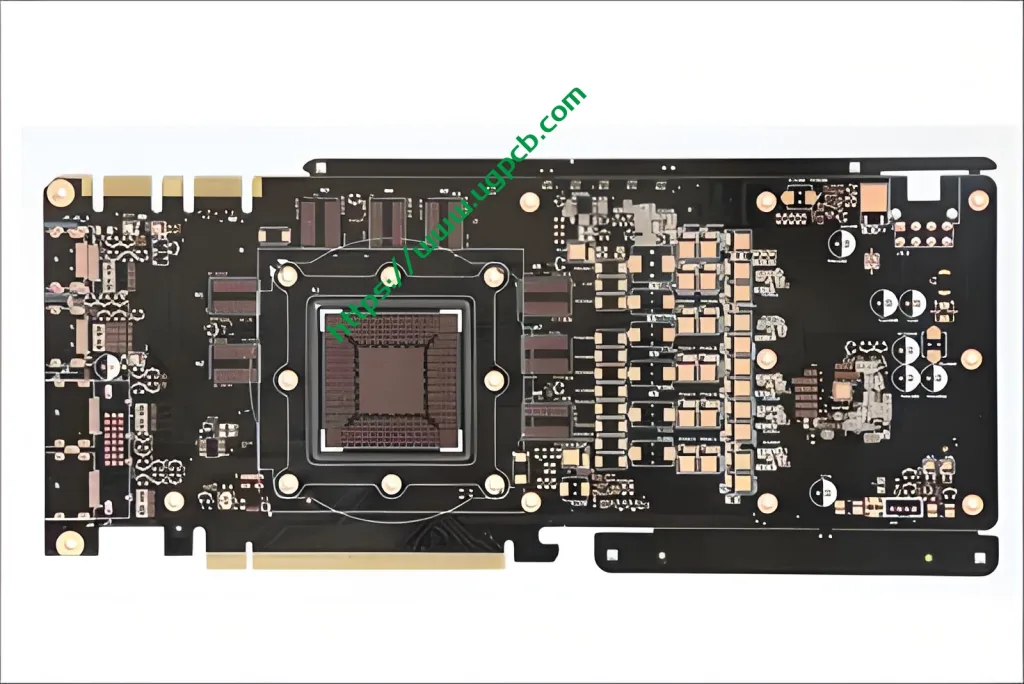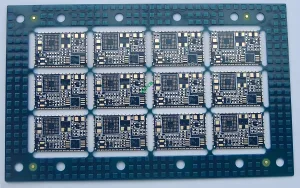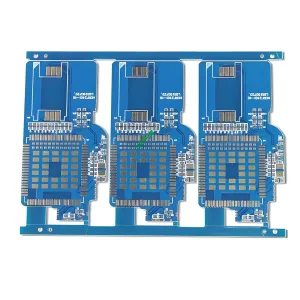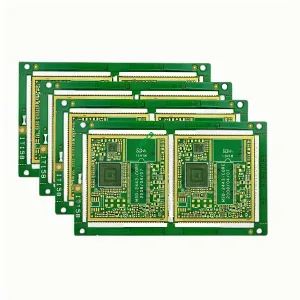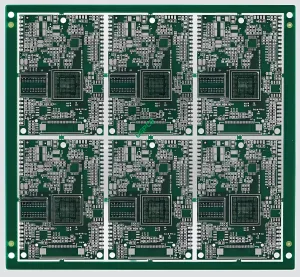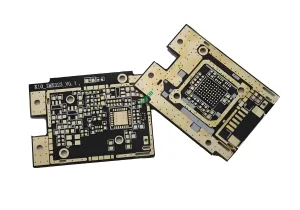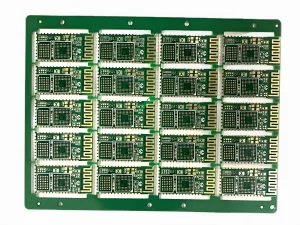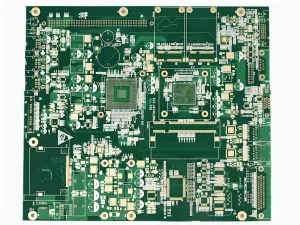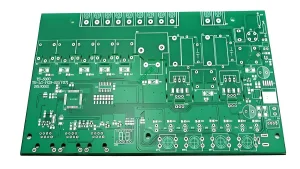컴퓨터 그래픽 카드 PCB 제품 개요
컴퓨터 그래픽 카드 PCB 란 무엇입니까??
컴퓨터 그래픽 카드 PCB, 또는 인쇄 회로 기판, 컴퓨터 화면에 그래픽 및 이미지를 렌더링하는 데 필요한 구성 요소를 수용하도록 설계된 특수 전자 회로 보드입니다.. 그래픽 카드의 중추 역할을합니다, 다양한 전자 부품 연결 및 전기 신호의 흐름을 용이하게.
정의 및 기능
컴퓨터 그래픽 카드 PCB는 본질적으로 그래픽 카드의 마더 보드입니다.. GPU에 필요한 연결 및 경로를 제공합니다. (그래픽 처리 장치), 메모리 모듈, 전원 공급 장치, 그리고 함께 의사 소통하고 기능하기위한 다른 필수 구성 요소. PCB는 이러한 구성 요소가 올바르게 상호 연결되도록합니다, 그래픽 카드가 복잡한 시각적 데이터를 효율적으로 처리하고 렌더링하도록 허용.
작동 원리
컴퓨터 그래픽 카드 PCB의 작동 원리는 전기 신호 전송을 중심으로 회전합니다.. 컴퓨터가 그래픽 명령을 보낼 때, GPU는이 명령을 처리하고 해당 신호를 생성합니다.. 그런 다음이 신호는 PCB의 전도성 트레이스를 통해 다양한 구성 요소로 전송됩니다., 메모리 모듈 및 디스플레이 커넥터와 같은. PCB는 이러한 신호가 이동하는 매체 역할을합니다., 그들이 의도 한 목적지에 정확하고 효율적으로 도달하도록 보장.
응용
컴퓨터 그래픽 카드 PCB는 주로 그래픽 기능을 향상시키기 위해 데스크탑 및 랩톱 컴퓨터에서 주로 사용됩니다.. 그들은 또한 게임 콘솔에서 발견됩니다, 워크 스테이션, 고성능 그래픽 처리가 필요한 기타 장치. 추가적으로, 그래픽 디자인과 같은 전문 분야에서 사용됩니다., 비디오 편집, 및 3D 모델링, 강력한 그래픽 기능이 필수적인 곳.
분류
컴퓨터 그래픽 카드 PCB는 몇 가지 요소를 기반으로 분류 할 수 있습니다., 그들의 층 수를 포함하여, 재료, 그리고 표면 처리. 레이어 수는 PCB 내 전도성 층 수를 나타냅니다., 더 높은 층 수는 일반적으로 더 나은 성능과 더 복잡한 회로를 제공합니다.. PCB에 사용되는 재료는 다를 수 있습니다, FR4를 포함한 일반적인 재료로, CEM-1, 및 S1141. 표면 처리는 PCB 표면에 적용되는 코팅을 말합니다., 몰입 금 또는 금 손가락 도금과 같은, 이는 전도성을 향상시키고 부식을 방지하는 데 도움이됩니다.
재료 구성
컴퓨터 그래픽 카드 PCB는 S1141이라는 특정 자료를 사용하여 만들어집니다.. 이 재료는 우수한 전기 특성을 위해 선택됩니다, 열 안정성, 그리고 기계적 강도. 그래픽 카드 구성 요소를위한 신뢰할 수 있고 내구성있는 플랫폼을 제공합니다., 최적의 성능과 수명을 보장합니다.
성능 특성
컴퓨터 그래픽 카드 PCB의 성능은 몇 가지 요인에 의해 영향을받습니다., 레이어 수를 포함하여, 구리 두께, 최소 트레이스/공간. 이 경우, PCB는 레이어 수가 있습니다 6 레이어, 복잡한 회로 및 효율적인 신호 라우팅을위한 충분한 공간 제공. 구리 두께는 1oz입니다, PCB의 전도성 층에 사용되는 구리 호일의 무게를 나타냅니다.. 더 두꺼운 구리 층은 일반적으로 더 나은 전기 전도도와 열 소산을 제공합니다.. 최소 추적과 공간은 모두 3mil입니다(0.075mm), PCB의 전도성 트레이스 사이의 가장 작은 폭과 간격을 나타냅니다.. 작은 흔적과 공간은 더 복잡하고 컴팩트 한 회로 설계를 가능하게합니다., 그래픽 카드의 전반적인 성능 향상.
구조적 특징
컴퓨터 그래픽 카드 PCB는 금 손가락 전기 도금 하드 골드 특성을 특징으로합니다.. 금 손가락 도금에는 PCB의 가장자리가 금 층으로 코팅됩니다., 연결성을 향상시키고 신호 손실 또는 간섭의 위험을 줄입니다.. 하드 골드 도금은 추가 내구성과 마모에 대한 저항성을 제공합니다., 그래픽 카드와 마더 보드 또는 기타 장치 간의 안정적인 연결 보장.
생산 과정
컴퓨터 그래픽 카드 PCB의 생산 프로세스에는 여러 단계가 포함됩니다., 디자인 포함, 제작, 그리고 조립. 설계 단계에는 회로 다이어그램을 만드는 것이 포함됩니다 (개략도) 및 PCB의 레이아웃, 구성 요소의 배치를 고려합니다, 추적 라우팅, 다른 디자인 고려 사항. 일단 디자인이 완료되면, 제조 단계가 시작됩니다, 여기에는 구리 층 에칭이 포함됩니다, 구성 요소 리드의 드릴링 구멍, 표면 처리를 적용합니다. 마지막으로, 조립 단계에서, 구성 요소는 PCB에 납땜됩니다, 완제품의 품질과 기능을 보장하기 위해 필요한 테스트 및 검사가 수행됩니다..
사용 사례
컴퓨터 그래픽 카드 PCB는 고성능 그래픽 처리가 필요한 광범위한 시나리오에서 사용됩니다.. 그들은 일반적으로 게임 굴착 장치에서 발견됩니다, 현실적이고 몰입 형 게임 경험을 렌더링하는 데 필요한 힘을 제공하는 곳. 그래픽 디자인과 같은 작업에 전문 워크 스테이션에도 사용됩니다., 비디오 편집, 그리고 애니메이션, 정확하고 상세한 시각적 표현이 중요합니다. 추가적으로, 그들은 가상 현실 시스템에 활용됩니다, 의료 영상 장비, 고급 그래픽 기능을 요구하는 다른 응용 프로그램.
 UGPCB 로고
UGPCB 로고

